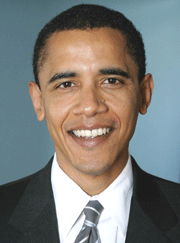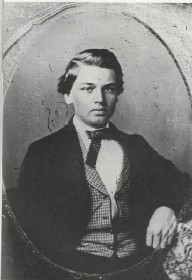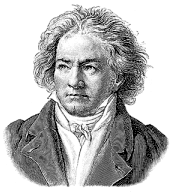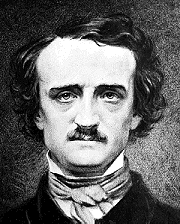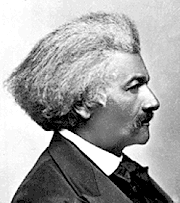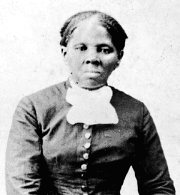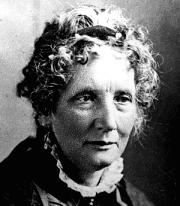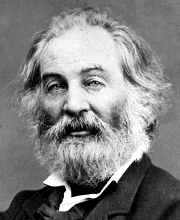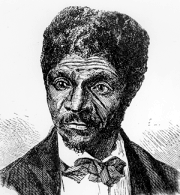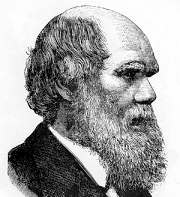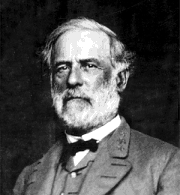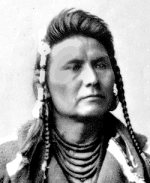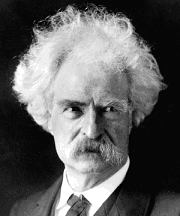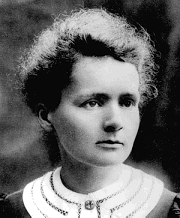Winner of the 2008 U.S. presidential election
by Liz Olson and Jennie Wood
After a historic and bruising 22-monthlong campaign, Sen. Barack Obama was elected the 44th president of the United States on Nov. 4, 2008. He prevailed over Sen. John McCain in what was probably the most pivotal U.S. election since World War II. He took the oath of office on Jan. 20, 2009, and became the first black U.S. president.
Two days into his presidency, Obama reversed some of the most controversial policies of the Bush administration. He signed executive orders that ended the Central Intelligence Agency's secret interrogation program, began the process to close the Guantánamo Bay detention camp, and established a cabinet-level panel that will formulate a plan to detain and question terrorism suspects in the future. Obama's orders said that the C.I.A. can only use the 19 interrogation methods mentioned in the Army Field Manual. The move ended Bush's policy of allowing the CIA to use methods that were not permitted by the military.
"We believe we can abide by a rule that says we don't torture, but we can effectively obtain the intelligence we need," Obama said.
Campaign battle
By taking advantage of the Internet and the power of text messaging on mobile phones, Obama ran an innovative campaign that appealed to young voters. Shunning public financing for his election, Obama raised an unprecedented amount of money, much of it from small donors. Until the financial crisis struck in mid-September, the wars in Iraq and Afghanistan dominated the campaign. Obama presented himself as the candidate for change and stressed that a McCain presidency would mirror the policies of the Bush administration.
As a political newcomer, Obama faced an uphill battle in convincing voters that he would be ready to lead the nation. Indeed, throughout the long and often bitter campaign for the Democratic nomination, he and Sen.
Hillary Clinton ran neck-and-neck in the primaries and caucuses. Obama and Clinton competed fiercely for the support of working-class voters, and each candidate tried to paint the other as elitist. Obama met sharp criticism for his association with his former pastor, the combative and controversial Rev. Jeremiah Wright. Obama denounced Wright after several of his divisive sermons popped up in the media. Wright's charged statements prompted Obama to address the race issue, and he earned wide praise for his speech on race relations,
"A More Perfect Union."
Running as the candidate of change, Obama made hope the center of his campaign. His platform focused on advocating for working families and poor communities, education, caring for the environment, and ethics reform.
Formative Years
Obama was born in
Hawaii to a Kenyan father and American mother. His father was raised in a small village in Kenya where he herded goats until he earned a scholarship to study in America. After his parents divorced, Obama's Harvard-educated father then returned to Kenya, where he worked in the economics ministry. Obama was raised by his mother in both Hawaii and Jakarta, Indonesia. He later moved to New York City to attend Columbia University, where he earned his undergraduate degree.
Obama moved to Chicago after college and worked extensively in the inner city to improve living conditions and reduce the unemployment rate in high-crime neighborhoods. He then attended Harvard Law School, graduated magna cum laude, and served as the first African-American president of the Harvard Law Review. After receiving his degree from Harvard Law School, he returned to Chicago and practiced as a civil rights lawyer.
Personal Life
Obama is married to
Michelle Obama, a Chicago native who also graduated from Harvard Law School. Barack and Michelle met in Chicago, where they both worked for the law firm Sidley and Austin. Michelle worked in corporate law for three years before pursuing a career in public service. She has worked for the city of Chicago, and she co-founded Public Allies, which helps young adults acquire skills to work in the public sector. In 2005 she was appointed vice president of community and external affairs at the University of Chicago Medical Center. Barack and Michelle have two daughters, Malia Ann and Sasha.
Political Career
His advocacy work on the local level in Chicago led to a run for the Illinois State Senate. Obama served for four years as a state senator and used his position to create programs such as the state Earned Income Tax Credit that provided more than $100 million in tax cuts to families over three years. He also generated an expansion in early childhood education and worked to pass legislation that requires all interrogations and confessions in capital cases to be videotaped.
Obama's eloquent keynote speech at the 2004 Democratic National Convention earned him wide praise him and cemented his reputation as one of the party's freshest and most inspirational new faces. In 2004, he was elected to the U.S. Senate, winning with 70% of the vote against the conservative black Republican, Alan Keyes. Obama became the only African-American serving in the U.S. Senate (and the fifth in U.S. history). Obama's idealism, commitment to civil rights, and telegenic good looks generated enormous media attention for his Senate campaign. He worked with Republicans on issues such as weapons control and ethics reform, yet voted with other Democrats against President Bush's surge of 20,000 troops to
Iraq and in favor of a resolution that required combat troops to be fully withdrawn by March 2008.
He served on the Senate's Health, Education, Labor, and Pensions Committee; the Foreign Relations Committee; the Veteran's Affairs Committee; and the Environment and Public Works Committee.
2008 Presidential Democratic Candidate Acceptance Speech
Obama accepted the Democratic presidential nomination before some 83,000 people at Invesco Field rather than the convention hall in Denver. His acceptance coincided with the 45th anniversary of the March on Washington, during which Rev. Martin Luther King Jr. gave his pivotal "I Have a Dream" speech. In his speech, Obama attacked John McCain on several fronts, including national security and his support for many of the policies of the Bush administration, and outlined his plans for the economy, the environment, and health care. Calling McCain out of touch with the economic woes of working-class America, Obama said, "It's not because John McCain doesn't care. It's because John McCain doesn't get it."
Obama's Presidency
Obama took office in the midst of a severe recession for the U.S. economy. His first major piece of legislative was the American Recovery and Reinvestment Act, a $787 billion spending bill, or "stimulus package," designed to create jobs and reignite the economy. He also acted quickly to bring about the change from the policies of the Bush administration that he had promised during the campaign. Two days after his inauguration he signed an executive order to close the controversial detention facility in Guantanamo Bay, Cuba within the year. Soon to follow were executive orders that reversed Bush's policies on stem cell research and interrogation techniques for enemy detainees.
In 2009, Obama pushed Congress to pass legislation on health care reform in the United States. Health care reform was a chief legislative goal and a major campaign promise. After months of debate, on March 21, 2010, the health care bill, which was passed by the Senate in December 2009, was passed by the House. The vote in the House was 219 to 212. On March 23, 2010, Obama signed the bill into law. In the November 2010 election, the Democrats lost 63 seats, therefore, losing control of the House of Representatives. In a speech about the election outcome, Obama called the loss "humbling" and blamed it on the slow economic recovery. The following summer, Congress became gridlocked in a battle over whether to raise the debt ceiling, causing the government to almost default. Because of the gridlock, Standard & Poor's downgraded the nation's credit rating for the first time in history. In August 2011, there were signs that the recovery from the 2008 recession had stalled with job growth continuing to come up short, the unemployment rate hovering at just over 9 %, and the stock market experiencing wild ups and downs. All of this giving fuel to the Republican presidential candidates as they headed out on the campaign trail to fight for the chance to run against Obama in 2012.
READ MORE.. »»

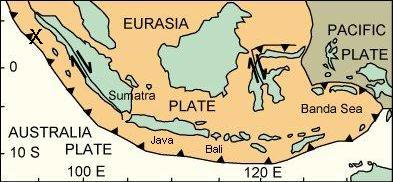



 On cross examination, defense attorney Michael Flanagan pressed Steinberg about his assumption that Murray was only out of the room for two minutes when Jackson became unresponsive, as Murray claimed in his police interview.
On cross examination, defense attorney Michael Flanagan pressed Steinberg about his assumption that Murray was only out of the room for two minutes when Jackson became unresponsive, as Murray claimed in his police interview.